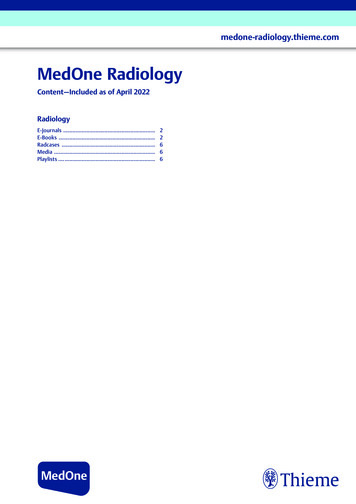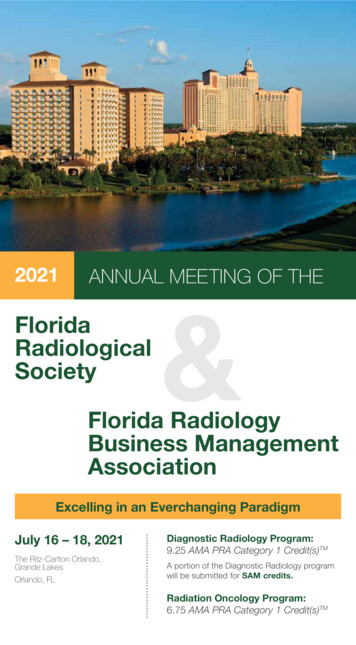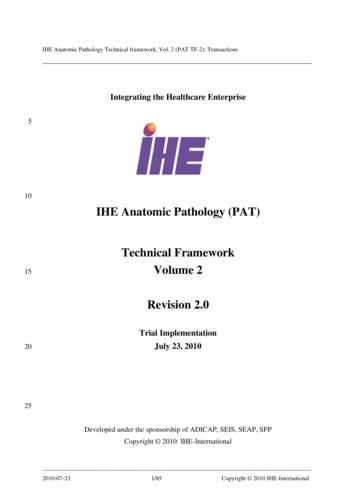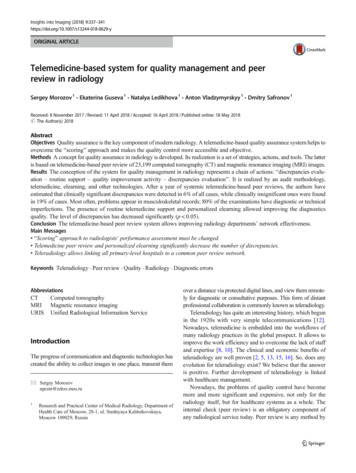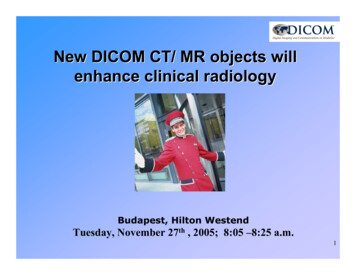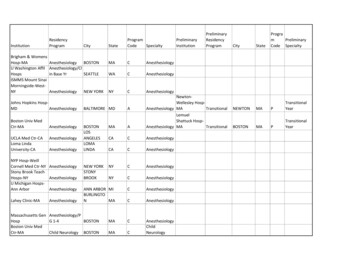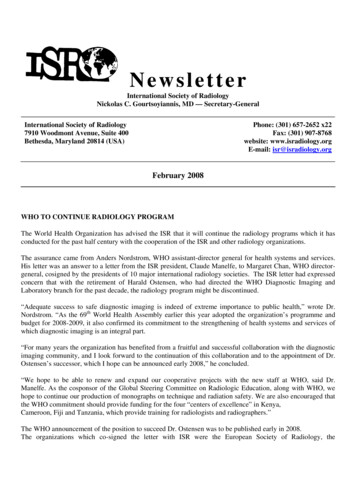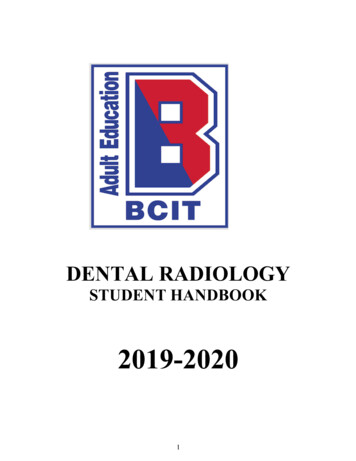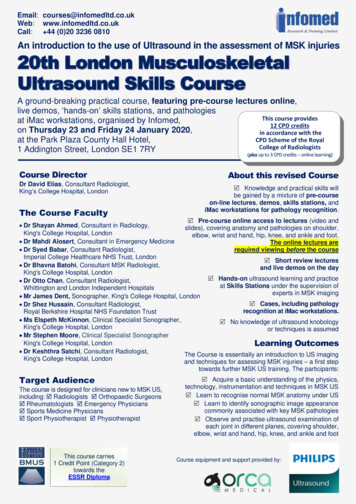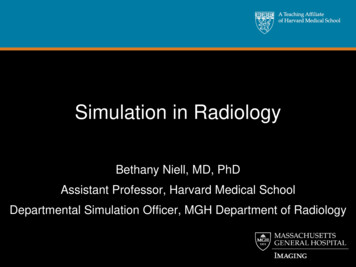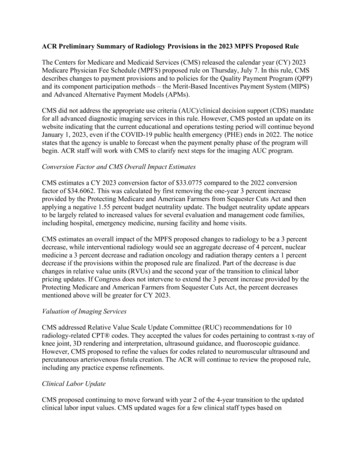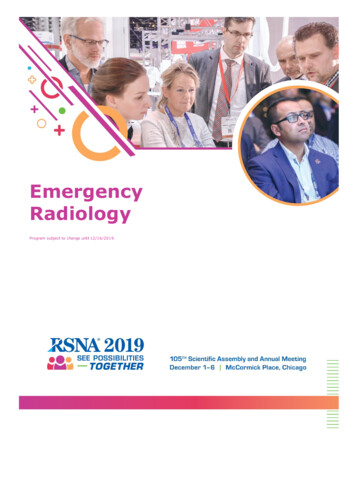
Transcription
EmergencyRadiologyProgram subject to change until 12/16/2019.
ER001-EB-XForeign Body Within the Abdominal Cavity: Emphasis on Its Potential ComplicationsAll Day Room: ER Community, Learning Center Hardcopy BackboardAwardsCertificate of MeritParticipantsYong-soo Kim, MD, PhD, Guri, Korea, Republic Of (Presenter) Nothing to DiscloseOn-Koo Cho, MD, PhD, Seoul, Korea, Republic Of (Abstract Co-Author) Nothing to DiscloseYoungseo Cho, MD, Seoul, Korea, Republic Of (Abstract Co-Author) Nothing to DiscloseFor information about this presentation, contact:ysookim@hanyang.ac.krTEACHING POINTSDescribe the CT appearances of common and uncommon intraluminal and extraluminal foreign bodies in the abdominopelvic cavity.Discuss the clinical implications and potential clinical complications of the foreign bodies which need emergency care in thegastrointestinal tract and abdominopelvic cavity.TABLE OF CONTENTS/OUTLINE1. Intraluminal foreign bodies 1) Ingested foreign body without complication 2) Ingested foreign body with perforation of bowelloops 3) Acute appendicitis from foreign body 4) Intraluminal foreign body penetrating into adjacent pancreas 5) Inserted intrarectalforeign body 6) Bezoar 7) Gall stone ileus 8) Dislodged tubes of prior procedures (biliary stent, PEG tube) 2. Extraluminal foreignbodies 1) Spillage of gall stones or clips in peritoneal cavity after cholecystectomy 2) Migration of intrauterine devices 3) Migrationof ventriculo-peritoneal or subdural -peritoneal shunt tube. 4) Remained bioabsorbable sponges after operation 5) Accidentallyintroduced foreign body during operation 6) Gossypiboma 7) Intraperitoneal foreign body with abscess formationPrinted on: 10/29/20
ER003-EB-XDual-Energy CT: How to Use it to Salvage Suboptimal CT AngiogramsAll Day Room: ER Community, Learning Center Hardcopy BackboardParticipantsMatthew Diamond, MD, Boston, MA (Presenter) Nothing to DiscloseAvneesh Gupta, MD, Boston, MA (Abstract Co-Author) Nothing to DiscloseFor information about this presentation, contact:Matthew.Diamond@bmc.orgTEACHING POINTSUnderstand the basic theory of DECT and its various reconstruction techniques. Illustrate how to reconstruct DECT raw data tomaximize the conspicuity of Iodine using low keV monoenergy images. Demonstrate methods to suppress calcifications inatherosclerotic plaques to more accurately estimate arterial stenosis.TABLE OF CONTENTS/OUTLINEBasic theory of DECT and its various reconstruction tecniques Use of low energy keV monoenergy reconstructions of DECT raw datato maximize density of IV contrast Use of virtual non-constrast images for detection of intramural hematomas Sample casesPrinted on: 10/29/20
ER004-EB-XDon't Stop Me Now: The CTA Lyrics to a Fast and Accurate Treatment of Abdominal Active BleedingAll Day Room: ER Community, Learning Center Hardcopy BackboardParticipantsEduardo N. Mendes, MD, Pilar, Argentina (Presenter) Nothing to DiscloseAgustina Di Cio, MD, Pilar, Argentina (Abstract Co-Author) Nothing to DiscloseMaria d. Astorga, MD, Pilar, Argentina (Abstract Co-Author) Nothing to DiscloseMartin G. Vargas, Pilar, Argentina (Abstract Co-Author) Nothing to DiscloseJuan F. Trentacoste Mossali I, MD, Pilar, Argentina (Abstract Co-Author) Nothing to DiscloseJuan P. Perotti, MD, Pilar, Argentina (Abstract Co-Author) Nothing to DiscloseFederico G. Diaz Telli, MD, Pilar, Argentina (Abstract Co-Author) Nothing to DiscloseJonathan Rosenvasser, MD, Pilar, Argentina (Abstract Co-Author) Nothing to DiscloseFor information about this presentation, contact:nicomendes10@gmail.comTEACHING POINTSTo review the principal active abdominopelvic bleeding causes. To discuss the role of US and CT angiography in the clinicalmanagement of acute abdominopelvic bleeding. To analyze the CT angiography protocol in patients with suspected acuteabdominopelvic bleeding. To highlight the importance of unenhanced phases and the utility of MIP & 3D reconstructions whendetecting hemorrhage sources. To provide the diagnostic keys findings in CT angiography needed to determine an appropriatetreatment.TABLE OF CONTENTS/OUTLINEIntroduction & main concepts CTA Key findings: fast hemorrhage localization The determinant role of CT Angiography in patientmanagement Abdominopelvic Bleeding Cases Gastrointestinal bleedings Esophageal varices Gastric ulcer Duodenal ulcer Small bowel& colon Hepatic bleeding Splenic bleeding Urinary bleeding Renal Bladder Genital bleeding Uterus Hemorrhagic follicle Ectopicpregnancy Testicular Abdominal aorta bleeding Aneurism rupture Active bleeding simulators and pitfalls ConclusionPrinted on: 10/29/20
ER100-ED-XThe Radiologist's Role in Stratifying Blunt Chest Trauma Incorporating Best Practice Reporting GuidelinesAll Day Room: ER Community, Learning Center Digital Education ExhibitParticipantsDaniel A. Hynes, MD, Springfield, MA (Presenter) Nothing to DiscloseAngelica Patino, MD, Springfield, MA (Abstract Co-Author) Nothing to DiscloseAndrew Doben, MD, Springfield, MA (Abstract Co-Author) Consultant, Johnson & Johnson; Consultant, Zimmer Biomet Holdings, IncKal Dulaimy, MD, Springfield, MA (Abstract Co-Author) Nothing to DiscloseTEACHING POINTSAcute rib fractures are common and a sign of significant trauma to the thorax. Multilevel rib fractures can be debilitating and causesignificant respiratory compromise particularly in the setting of flail chest. Recent upgrades in surgical stabilization technique fordisplaced rib fractures have seen increased employment of rib stabilization for the management of flail chest and significant chestdeformity. We review classes of chest trauma and associated injury patterns to include hemopneumothorax, pulmonary contusionwith laceration, traumatic lung hernia and pulmonary artery pseudoaneurysm. Finally we propose a standardized guideline forreporting and scoring the severity of chest trauma incorporating RibScore and Blunt Pulmonary Contusion-18 scores by theinterpreting radiologist to stratify those patients who will benefit from rib fixation.TABLE OF CONTENTS/OUTLINE Introduction Objectives Epidemiology and pathophysiology of blunt chest trauma Features and sequelae of acute rib fracturesexploring injury patterns of chest trauma including hemopneumothorax, pulmonary contusion/laceration, traumatic lung hernia,vascular injury and pulmonary artery pseudoaneurysm ACR appropriateness criteria for imaging Standardized guideline for reportingand scoring the severity of chest trauma using RibScore and Blunt Pulmonary Contusion-18 score Summary ReferencesPrinted on: 10/29/20
ER101-ED-XThe Night is Dark and Full of Terrors: A Primer for Overnight Blind Spots for the On-Call RadiologistAll Day Room: ER Community, Learning Center Digital Education ExhibitParticipantsCorbin L. Pomeranz, MD, Philadelphia, PA (Presenter) Nothing to DiscloseChhavi Kaushik, MBBS, Chicago, IL (Abstract Co-Author) Nothing to DisclosePranshu Sharma, MD, Philadelphia, PA (Abstract Co-Author) Nothing to DiscloseSantosh K. Selvarajan, MD, Mount Laurel, NJ (Abstract Co-Author) Nothing to DiscloseFor information about this presentation, contact:corbin.pomeranz@jefferson.eduTEACHING POINTS1. Describe the normal anatomy of certain anatomical blind spots encountered overnight. 2. Recognize abnormal appearance fromnormal appearance of certain blind spots. 3. Highlight pitfalls in interpretation of findings in each blind spot. 4. Develop a searchpattern to avoid interpretation errors in evaluating overnight imaging studies from the ER.TABLE OF CONTENTS/OUTLINEIntroduction 1. Blind spots overview 2. Anatomy 3. Neuro Skull base Convexities Inner ear Orbits 4. Head & Neck Paraesophagealsoft tissues TMJ 5. Chest Lungs Pleura Bronchi Pulmonary arteries Heart Chest wall/breasts 6. Body Abdominal wall RetroperitoneumBowel Mesentary 7. Pelvis 8. MSK Upper extremity Lower Extremity 9. Nuclear Medicine 10. Search pattern for on call SummaryPrinted on: 10/29/20
ER102-ED-XImaging Findings of Rodeo Injuries in the Wild WestAll Day Room: ER Community, Learning Center Digital Education ExhibitParticipantsSean Connor, MD, Albuquerque, NM (Presenter) Nothing to DiscloseJonathan Revels, DO, Seattle, WA (Abstract Co-Author) Nothing to DiscloseJamie M. Elifritz, MD, Albuquerque, NM (Abstract Co-Author) Nothing to DiscloseSteven R. Tandberg, MD, Albuquerque, NM (Abstract Co-Author) Nothing to DiscloseJennifer S. Weaver, MD, Albuquerque, NM (Abstract Co-Author) Nothing to DiscloseFor information about this presentation, contact:jsweaver@salud.unm.eduTEACHING POINTSRodeo events are a high impact sport with a unique pattern of injuries. An analysis of the different mechanisms of injury based onthe individual events will aid radiologist pattern recognition and reporting. After viewing this exhibit, the learner should: Understandinjury mechanisms for the different rodeo events (roping, bull riding) Be able to identify the imaging findings of several differentacute rodeo injuries Be able to identify the imaging findings of several different chronic rodeo injuriesTABLE OF CONTENTS/OUTLINEIntroduction to rodeo events Mechanism of injury for individual events (roping, bull riding etc.) Imaging findings of several differentacute rodeo injuries, with example cases Imaging findings of several different chronic rodeo injuries, with example cases SummaryPrinted on: 10/29/20
ER103-ED-XBigger isn't Always Better: Review of Important Imaging Measurements for the On-Call Radiology ResidentAll Day Room: ER Community, Learning Center Digital Education ExhibitParticipantsMark Ehrhart, MD, Albuquerque, NM (Abstract Co-Author) Nothing to DiscloseJonathan Revels, DO, Seattle, WA (Presenter) Nothing to DiscloseJamie M. Elifritz, MD, Albuquerque, NM (Abstract Co-Author) Nothing to DiscloseJennifer S. Weaver, MD, Albuquerque, NM (Abstract Co-Author) Nothing to DiscloseFor information about this presentation, contact:jsweaver@salud.unm.eduTEACHING POINTSThe "on call" rotation, usually consisting of emergency department and inpatient service coverage by the radiology resident can bean extremely stressful time. Knowledge of certain measurements encountered during common emergent studies can help alleviatethis stress and help the resident provide accurate and timely patient care. After reviewing this exhibit, the learner should: Be awareof measurements encountered in the imaging findings of several emergent conditions Understand how to apply these measurementsto arrive at accurate diagnosesTABLE OF CONTENTS/OUTLINEIntroduction Commonly encountered imaging measurements and their diagnostic implications Musculoskeletal (e.g. femoral notch,acromioclavicular joint, Boehler's angle) Cardiovascular (e.g. aorta, cardiac, pulmonary artery, IVC) Gastrointestinal (e.g. pylorus,appendix, bowel lumen) Genitourinary (e.g. ovary, obstetrical) Neurologic (e.g. pre-dental space and other spine measurements,aneurysms) Imaging examples of normal and abnormal findings Peals and Pitfalls ConclusionPrinted on: 10/29/20
ER104-ED-XMRI Appearance of Clinical Mimics of Appendicitis in Pediatric PatientsAll Day Room: ER Community, Learning Center Digital Education ExhibitParticipantsRyne Dougherty, MD, Ann Arbor, MI (Presenter) Nothing to DiscloseTim I. Alves, MD, Ann Arbor, MI (Abstract Co-Author) Nothing to DiscloseJohn D. Millet, MD, Ann Arbor, MI (Abstract Co-Author) Nothing to DiscloseFor information about this presentation, contact:dryne@med.umich.eduTEACHING POINTSAbdominal pain with clinical concern for appendicitis is a common presentation in the pediatric emergency room. Diagnosis reliesheavily on imaging, with first line imaging typically being ultrasound. However, increasingly limited abdominal MRI are being utilizedwhen ultrasound is inconclusive or for problem-solving. While appendicitis is common, there are other clinical mimics of appendicitisthat can be encountered on MRI. Since the radiological findings help triage medical and surgical management, familiarity with thesemimics is critical. We will present a series of common and uncommon mimics of appendicitis on magnetic resonance imaging (MRI).While the exhibit will focus on the MRI findings, representative and corroborative findings from ultrasound and computedtomography (CT) will be included.TABLE OF CONTENTS/OUTLINEA cased based review of mimics of appendicitis on MRI: Bowel and Mesenteric/Omental Etiologies: terminal ileitis, ascending colitis,Meckel's Diverticulitis, ileocolic intussusception, & omental infarction Gynelogical Etiologies: ovarian torsion, isolated fallopian tubaltorsion, & tubo-ovarian abscess Genitourinary Etiologies: obstructing ureteral stone & pyelonephritis Musculoskeletal Etiologies:psoas myositisPrinted on: 10/29/20
ER105-ED-XBreast Emergency: How Do I Manage It?All Day Room: ER Community, Learning Center Digital Education ExhibitParticipantsJavier Azpeitia Arman, MD, Madrid, Spain (Presenter) Nothing to DiscloseRosa M. Lorente-Ramos, MD, PhD, Madrid, Spain (Abstract Co-Author) Nothing to DiscloseJose Manuel Garcia Gomez, MD, Madrid, Spain (Abstract Co-Author) Nothing to DiscloseCarlos Oliva Fonte, Madrid, Spain (Abstract Co-Author) Nothing to DiscloseGloria Liano Esteso, Madrid, Spain (Abstract Co-Author) Nothing to DiscloseDanilo E. Salazar Chiriboga, MD, Madrid, Spain (Abstract Co-Author) Nothing to DiscloseFor information about this presentation, contact:fjavier.azpeitia@salud.madrid.orgTEACHING POINTSTo review breast entities which may be cause of consultation in the Emergency Department, including clinical presentation, imagingand pathologic findings. To illustrate common and uncommon imaging findings both found in imaging techniques commonly employedin the ED (plain radiographs, CT, US) and dedicated breast imaging ( mammograms, MR) with pathologic correlation. To emphasizepitfalls and differential diagnosis, and clues for management .TABLE OF CONTENTS/OUTLINEDifferent pathological entities of the breast may present in the ED. The radiologist should be aware of differential diagnosis, imagingand management of the most common lesions. We present. 1. Breast anatomy 2. Lesions according to presentation.Inflammatory/infectious conditions (mastitis: infectious, granulomatous, eosinophilic); Trauma: blunt and penetrating (hematoma,bleeding, breast implant rupture); Palpable lumps (cysts, benign masses, cancer); Foreign bodies (sewing needle, injectedsubstances). 3. Specific lesions in different groups. Male breast (Ginecomastia); Newborn (Breast masses, transient thelarche),adolescents (ginecomastia, thelarche, fibroadenoma) , pregnancy ( benign tumors, cancer), puerperium (lactational adenoma,galactocele, puerperal mastitis).Printed on: 10/29/20
ER106-ED-XIns and Outs of Plain Radiographs of the Abdomen: Looking for Abdominal Air Where It Should Not BeAll Day Room: ER Community, Learning Center Digital Education ExhibitAwardsCertificate of MeritParticipantsJavier Azpeitia Arman, MD, Madrid, Spain (Presenter) Nothing to DiscloseRosa M. Lorente-Ramos, MD, PhD, Madrid, Spain (Abstract Co-Author) Nothing to DiscloseJose Maria Lopez-Arcas Calleja, Madrid, Spain (Abstract Co-Author) Nothing to DiscloseAna Casas Martin, Madrid, Spain (Abstract Co-Author) Nothing to DiscloseAlmudena Blazquez Saez, Madrid, Spain (Abstract Co-Author) Nothing to DiscloseAraceli Munoz Hernandez, MD, PHD, Madrid, Spain (Abstract Co-Author) Nothing to DiscloseFor information about this presentation, contact:fjavier.azpeitia@salud.madrid.orgTEACHING POINTS1. To present a series of challenging abdominal plain radiographs,with gas in a non-usual position, providing correlation with otherimaging methods (CT, US, MR). 2. To review and illustrate different entities presenting with air in abnormal location. 3. Toemphasize pitfalls, diagnostic difficulties and differential diagnosis.TABLE OF CONTENTS/OUTLINEWe provide a case-based presentation in a quiz format, consisting of plain abdominal radiographs that will help us to reviewdifferent entities presenting with abnormal abdominal gas. We add a description of findings, complementary studies (US,MR, CT) andillustrative pathologic images when available as well as normal tricky images. In the discussion keys to differential diagnosis will behighlighted. We present gas within: 1. Pneumoperitoneum, retropneumoperitoneum 2. Gastrointestinal tract. - Bowel wall:Pneumatosis intestinalis, coli , gastric pneumatosis - Gallbladder wall: emphysematous cholecystitis - Liver.Abscess,Aerobilia,Portalvein gas. - Pancreatic abscess, emphysematous pancreatitis, 3. Urinary tract. -Emphysematous pyelonephritis -Emphysematouspyelitis -Renal abscess -Emphysematous cystitis -Fournier gangrena 4.Abdominal wall : postoperative gas, necrotizing fascitis5.Pitfalls. Tubes, colostomy, tampons, postoperative gasPrinted on: 10/29/20
ER107-ED-XEmergency Imaging Assessment of Intracranial Complications of Acute ENT InfectionsAll Day Room: ER Community, Learning Center Digital Education ExhibitParticipantsCristina Ponce Balaguer, MD, Palma de Mallorca, Spain (Presenter) Nothing to DiscloseBeatriz Miriam Rodriguez Chikri, MD, Palma de Mallorca, Spain (Abstract Co-Author) Nothing to DiscloseMaria Angeles M. Martin, MD, Palma de Mallorca, Spain (Abstract Co-Author) Nothing to DiscloseMargarita Palmer Sans, Palma de Mallorca , Spain (Abstract Co-Author) Nothing to DiscloseAna Arias Medina, MD, Palma de Mallorca, Spain (Abstract Co-Author) Nothing to DiscloseAntonio Mas Bonet, MD, Palma de Mallorca , Spain (Abstract Co-Author) Nothing to DiscloseFor information about this presentation, ING POINTS1. To review the intracranial complications acute of otorhinolaryngological infections, that may be seen in the emergency setting.2. Keep in mind that patients can have variable presentations according to the site and extent of the infection. 3. Describe the CTand MR imaging findings of common intracranial complications of otorhinolaryngological infections.TABLE OF CONTENTS/OUTLINE1. Description of ENT Infections: a. Oral Cavity b. Oropharynx c. Retropharynx d. Orbits and Sinuses e. EAR infections 2. Review ofIntracranial complications of acute ENT infections. a. Extradural/subdural empyema b. Intracranial abscess c. Subperiosteal abscessd. Vascular complications: acute stroke, cerebral sinus venous thrombosis, Mycotic pseudoaneurysms, vasculitis 3. Radiographicfindings of intracranial complications of otorhinolaryngological infections in emergency radiology. a. Meningitis findings:leptomeningeal enhancement b. Ischemic injury c. Hydrocephalus d. Subdural/epidural empyema e. Cerebritis and cerebral abscessf. Ventriculitis g. Dural sinus thrombosisPrinted on: 10/29/20
ER108-ED-XAbout to Blow Up!: Cased-based Review of Impending Signs of Aortic Rupture, Treatment, and EndoleakComplicationsAll Day Room: ER Community, Learning Center Digital Education ExhibitAwardsCertificate of MeritParticipantsChristian A. Cabrera, MD, Mexico City, Mexico (Presenter) Nothing to DiscloseSergio A. Criales Vera, MD, Mexico, Mexico (Abstract Co-Author) Nothing to DiscloseHugo Torres Rodriguez, MD, Mexico City, Mexico (Abstract Co-Author) Nothing to DiscloseMaria de la Luz Jimenez Camacho, MD, Mexico City, Mexico (Abstract Co-Author) Nothing to DiscloseAndres F. Herrera Jimenez, MD, Mexico City, Mexico (Abstract Co-Author) Nothing to DiscloseFor information about this presentation, contact:chrisabadcg@gmail.comTEACHING POINTS Aortic rupture carries a critical sense of urgency given that the integrity of the vascular system is crucial to maintaining the vitalblood supply to the various organ systems. Consequently, specific clinical scenarios demand immediate action to determinewhether the aorta is intact or damaged and if it can maintain adequate perfusion. The radiologist must know how to recognize thebroad spectrum of signs that fit the criteria to be considered a vascular emergency, and prompt and accurate diagnosis isindispensable to allow the treating physician to determine the best therapeutic approach. It is essential that we as the radiologistneed to be aware of the postoperative complications appearance of this entity to make sure if re-intervention it needs it or not.TABLE OF CONTENTS/OUTLINETABLE OF CONTENT.-Introduction.-Impending signs of aortic rupture. -Aortic Rupture. -Pre-surgical complications-Treatment Endoleak complications -Tips and mimics (it s not a rupture)-Conclusion.Printed on: 10/29/20
ER109-ED-XImage Overload: How to Approach an Emergency Brain MRIAll Day Room: ER Community, Learning Center Digital Education ExhibitParticipantsHugo F. Bueno, MD, Jersey City, NJ (Presenter) Nothing to DiscloseEsther A. Nimchinsky, MD,PhD, Newark, NJ (Abstract Co-Author) Nothing to DiscloseMeir H. Scheinfeld, MD, PhD, Suffern, NY (Abstract Co-Author) Nothing to DiscloseMahmoud Dakhel, MD, New York, NY (Abstract Co-Author) Nothing to DiscloseRobert J. Dym, MD, Bergenfield, NJ (Abstract Co-Author) Nothing to DiscloseTEACHING POINTSIn the emergency setting, brain MRI may be obtained following a negative or inconclusive head CT, or to further characterizefindings seen on CT. When approaching the interpretation of a brain MRI, following a step-wise algorithm allows the radiologist toaccurately and efficiently diagnose pathology and to avoid satisfaction of search. Key brain MRI sequences include: DWI/ADC,GRE/SWI, FLAIR, T2W, T1W without contrast, and T1W with contrast (if performed) Specific diagnoses often require informationgleaned from more than one sequence.TABLE OF CONTENTS/OUTLINEMRI brain sequences and signal characteristics Sequence-based approach emphasizing normal signal characteristics and pathologicchanges: 1) DWI/ADC 2) GRE/SWI 3) FLAIR 4) T2W 5) T1W without contrast 6) T1W with contrast (if performed) Review of specificcase examples from the emergency setting including stroke, infectious processes, metabolic processes, hydrocephalus, masslesions, etc.Printed on: 10/29/20
ER110-ED-XThe Family Jewels: Pearls for Imaging Patients with Acute Scrotal PainAll Day Room: ER Community, Learning Center Digital Education ExhibitAwardsCertificate of MeritParticipantsJeremy Ross, MD, Ann Arbor, MI (Presenter) Nothing to DiscloseErica B. Stein, MD, Ann Arbor, MI (Abstract Co-Author) Nothing to DiscloseWilliam Masch, MD, Ann Arbor, MI (Abstract Co-Author) Nothing to DiscloseJohn D. Millet, MD, Ann Arbor, MI (Abstract Co-Author) Nothing to DiscloseTEACHING POINTS1. Acute scrotal pain can be precipitated by infectious, traumatic, vascular, and inflammatory etiologies, all of which are bestevaluated at ultrasound. 2. Knowledge of characteristic imaging findings at ultrasound and the patient's clinical history canfacilitate an accurate diagnosis and guide appropriate management. 3. Close imaging follow-up is needed after treatment for manyetiologies of acute scrotal pain to exclude an underlying malignancy.TABLE OF CONTENTS/OUTLINEI. Introduction a. Key anatomy b. Technical tips II. Infectious etiologies a. Epididymitis and epididymo-orchitis b. Intratesticularabscess c. Pyocele d. Fournier's gangrene III. Traumatic etiologies a. Testicular rupture b. Testicular contusion/intratesticularhematoma c. Hematocele IV. Vascular etiologies a. Testicular torsion b. Paratesticular appendage torsion c. Segmental testicularinfarction d. Varicocele V. Inflammatory etiologies a. Epididymitis nodosa (sperm granuloma) b. Granulomatous orchitis c. Testicularsarcoidosis VI. Pitfalls a. Incidental intratesticular mass i. Seminoma and other primary neoplasms ii. Lymphoma iii. Epidermoid cystb. Incidental extratesticular mass i. Adenomatoid tumor VII. ConclusionPrinted on: 10/29/20
ER111-ED-XThe Perilous Pancreas: A Multimodality Review of Pancreatic TraumaAll Day Room: ER Community, Learning Center Digital Education ExhibitAwardsMagna Cum LaudeIdentified for RadioGraphicsParticipantsAndres R. Ayoob, MD, Lexington, KY (Presenter) Nothing to DiscloseJames T. Lee, MD, Lexington, KY (Abstract Co-Author) Nothing to DiscloseDavid Turner, Lexington, KY (Abstract Co-Author) Nothing to DiscloseMohamed Issa, MD, Lexington, KY (Abstract Co-Author) Nothing to DiscloseChristina A. LeBedis, MD, Boston, MA (Abstract Co-Author) Nothing to DiscloseAshwin Jain, MD, Boston, MA (Abstract Co-Author) Nothing to DiscloseJorge A. Soto, MD, Boston, MA (Abstract Co-Author) Royalties, Reed ElsevierFor information about this presentation, contact:andres.ayoob@uky.eduTEACHING POINTSDiscuss potential perils in pancreatic assessment in the setting of blunt abdominal trauma Illustrate imaging findings in traumaticpancreatic injuries, emphasizing a multi-modality approach and the importance of determining pancreatic duct integrity Explainmanagement options in relationship to imaging findings/injury grading systemsTABLE OF CONTENTS/OUTLINEAnatomic considerations and pathophysiology Clinical findings Imaging Evaluation: Modalities: CT, MRI/MRCP, ERCP Imaging findings:Direct Secondary Complications Grading/classification Management optionsPrinted on: 10/29/20
ER112-ED-XMDCT Atlas of AAST Solid Organ Injury Scaling 2019 UpdateAll Day Room: ER Community, Learning Center Digital Education ExhibitParticipantsHyohyeon Yu, Ujeonbu , Korea, Republic Of (Presenter) Nothing to DiscloseYoung-Mi Ku, MD, Uijeongbu, Korea, Republic Of (Abstract Co-Author) Nothing to DiscloseYoo-Dong Won, MD, Detroit, MI (Abstract Co-Author) Nothing to DiscloseYunsup Hwang, Uijeongbu, Korea, Republic Of (Abstract Co-Author) Nothing to DiscloseSulim Lee, MD, Uijeongbu , Korea, Republic Of (Abstract Co-Author) Nothing to DiscloseTEACHING POINTS1. To demonstrate the significant change of 2018 revised AAST organ injury scaling of the spleen, liver and kidney. 2. To describeMDCT findings of organ injury scaling based on 2018 updated AAST OIS and managementTABLE OF CONTENTS/OUTLINE1. Introduction 1. Significant changes in the 2018 revised AAST organ injury scaling 1) The new OIS includes three sets of criteriato assign grade: imaging, operative and pathologic. 2) The incorporation of CT diagnosed vascular injury, defined as either as apseudoaneurysm or arteriovenous fistula, into the new OIS 2. 2018 updated organ injury scaling 1) Spleen 2) Liver 3) Kidney 2.MDCT findings of AAST organ injury scales based on 2018 revision 1. MDCT findings of vascular injury 1) Uncontained vascular injuryAcute contrast extravasation, dissection and/or thrombosis 2) Contained vascular injury Pseudoaneurysm, arteriovenous shunt 2.Spleen 1) MDCT findings of AAST OIS 2) Management 3. Liver 1) MDCT findings of AAST OIS 2) Management 4. Kidney 1) MDCTfindings of AAST OIS 2) ManagementPrinted on: 10/29/20
ER113-ED-XThe On-Call Radiology Residents Guide to Managing the Reading Room: Distractions, Downtimes, andDiscussionsAll Day Room: ER Community, Learning Center Digital Education ExhibitParticipantsJoseph W. Owen, MD, Lexington, KY (Presenter) Nothing to DiscloseAhmed A. Faraq, MD, Louisville, KY (Abstract Co-Author) Nothing to DiscloseBrent Pressman, DO, Lexington, KY (Abstract Co-Author) Nothing to DiscloseJames T. Lee, MD, Lexington, KY (Abstract Co-Author) Nothing to DiscloseAndres R. Ayoob, MD, Lexington, KY (Abstract Co-Author) Nothing to DiscloseTEACHING POINTSAt the end of this exhibit residents should be able to: Recall strategies to minimize the impact of distractions. Execute a plan forwhen electronic systems go down. Describe skills for effective communication with referring clinicians.TABLE OF CONTENTS/OUTLINEDistractions: Phone calls: Who takes calls? How to prioritize calls? When to call the attending? Protocoling: What to individuallyprotocol? How to change a protocol? When and what contrast to use? Is it a true contrast allergy? Pre-medication? Environment:Who is in the reading room? Can you listen to music? When and where do you eat or drink? Downtimes: PACS: How do youinterpret images? Which images are a priority? How do you know what has been read? RIS: How do you issue a report? What formof report is issued? How are studies tracked after a downtime? Electronic Health Records: How do clinicians enter orders? Wheredo clinicians get the results? How do you get clinical information? Discussions: Curb-side consults: ED patients, inpatients, outsidehospital imaging. Documenting what was said. Dealing with resident-attending discrepancies. On-call procedures: LPs andfluoroscopy. When is it appropriate? After a review of best practices, the learner will be assessed with a case-based quiz requiringpractical decision-making skills.Printed on: 10/29/20
ER114-ED-X"Point of Care" in Abdominal Trauma: What Not to MissAll Day Room: ER Community, Learning Center Digital Education ExhibitParticipantsMerval Franklin V. Britto, MD, Sao Paulo, Brazil (Presenter) Nothing to DiscloseLorena C. Ferreira, MD, Sao Paulo, Brazil (Abstract Co-Author) Nothing to DiscloseMarcelo Oranges Filho, MD, Sao Paulo, Brazil (Abstract Co-Author) Nothing to DiscloseMicaela M. Mota, MD, Sao Paulo , Brazil (Abstract Co-Author) Nothing to DiscloseShri Krishna Jayanthi, MD, Sao Paulo, Brazil (Abstract Co-Author) Nothing to DiscloseMarcelo d. Gusmao, MD, Sao Paulo, Brazil (Abstract Co-Author) Nothing to DiscloseFernando I. Yamauchi, MD, Sao Paulo, Brazil (Abstract Co-Author) Nothing to DisclosePublio C. Viana, MD, Sao Paulo, Brazil (Abstract Co-Author) Nothing to DiscloseFernando M. Coelho, MD, Sao Paulo, Brazil (Abstract Co-Author) Nothing to DiscloseFor information about this presentation, contact:mervalveras@gmail.comTEACHING POINTSEstablish a systematic method of abdominal CT assessment in the trauma context Recognize critical CT findings that would requireimmediate surgical management Establish the exact location of the injury whether it is intraperitoneal, retroperitoneal orextraperitoneaTABLE OF CONTENTS/OUTLINE- INTRODUCTION - Epidemiology of abdominal trauma - MECHANISMS OF INJURY - Blunt or penetrating ab
Kal Dulaimy, MD, Springfield, MA (Abstract Co-Author) Nothing to Disclose TEACHING POINTS . MBBS, Chicago, IL (Abstract Co-Author) Nothing to Disclose Pranshu Sharma, MD, Philadelphia, PA (Abstract Co-Author) Nothing to Disclose . Sean Connor, MD, Albuquerque, NM (Presenter) Nothing to Disclose .
